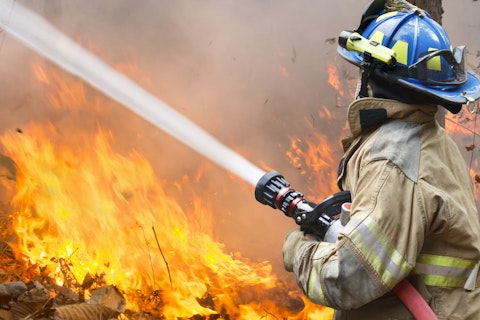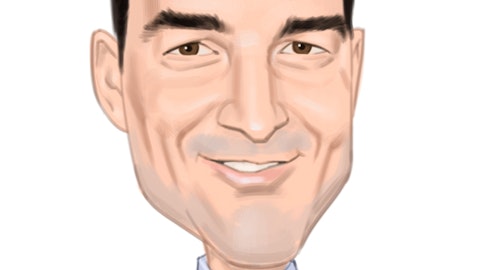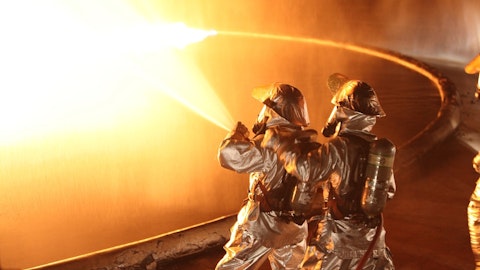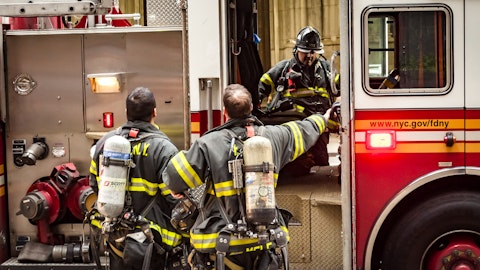Perimeter Solutions, SA (NYSE:PRM) Q4 2022 Earnings Call Transcript February 28, 2023
Operator: Greetings, and welcome to the Perimeter Solutions Fourth Quarter 2022 Earnings Call. At this time, all participants’ are in a listen-only mode. A brief question-and-answer session will follow the formal presentation. As a reminder, this conference is being recorded. It is now my pleasure to introduce your host, Seth Barker. Thank you, Mr. Barker. You may begin.
Seth Barker: Thank you, operator. Good morning, everyone, and thank you for joining Perimeter Solutions fourth quarter 2022 earnings call. Speaking on today’s call are Haitham Khouri, Vice Chairman; Edward Goldberg, Chief Executive Officer; and Chuck Kropp, Chief Financial Officer. We want to remind anyone who may be listening to a replay of this call that all statements made are as of today, February 28, 2023, and these statements have not been nor will they be updated subsequent to today’s call. Also, today’s call may contain forward-looking statements. These statements made today are based on management’s current expectations, assumptions and beliefs about our business and the environment in which we operate, and our actual results may materially differ from those expressed or implied on today’s call.
Please review our SEC filings for a more complete discussion of factors that could impact our results. The company would also like to advise you that during the call, we will be referring to non-GAAP financial measures, including EBITDA. The reconciliation of and other information regarding these items can be found in our earnings press release and presentation both of which will be available on our website and on the SEC’s website. With that, I will turn the call over to Haitham Khouri, Vice Chairman.
Haitham Khouri: Good morning, everyone, and thank you for joining us. Let me start off by introducing Seth Barker, our recently appointed Head of Investor Relations. Seth is a Perimeter veteran, having previously led both our specialty products and suppressants businesses. Seth is currently our Vice President of Financial Planning and Analysis, where he plays a key role in corporate and business unit level financial planning, measurement analysis and reporting. In addition to his role as VP of FP&A, Seth is also assuming primary responsibility for perimeter’s investor relations function where he will work closely with Eddie, Chuck and I as we engage with our debt and equity investors. Congratulations, Seth. And thank you for the continued excellent work.
Let me now make summary comments on our strategy before turning to our financial performance and capital allocation, starting with our strategy on slide three. Our goal is to deliver private equity like returns with the liquidity of a public market. We plan to attain this goal by owning, operating and growing uniquely high-quality businesses. We define uniquely high-quality businesses through the following five very specific economic criteria. One, recurring and predictable revenue streams. Two, long-term secular growth tailwinds. Three, products that account for critical, but small portions of larger value streams. Four, significant free cash flow generation with higher returns on tangible capital. And five, the potential for opportunistic consolidation.
We believe these five economic criteria are present at Perimeter’s current businesses and we use these criteria to evaluate potential new acquisitions. As described on slide four, we seek to drive long-term equity value creation by a consistent improvement in our three operational value drivers, which are profitable new business; continual productivity improvements; and pricing to reflect the value we provide. In addition to our three operational value drivers, we seek to maximize equity value creation, through a clear focus on the allocation of our capital, as well as the management of our capital structure. Turning now to our financial results and starting with Fire Safety. As we’ve discussed previously, that 2022 North America fire season was mild with U.S. acres burned ex-Alaska down 36% and Canadian hectors burned down 66%.
The fourth quarter was even milder with U.S. acres burned ex-Alaska down 47% and minimal fire activity in our markets outside of the United States. The impact of the mild €˜22 fire season is reflected in our full-year and Q4 Fire Safety results. The mild €˜22 fire season has no impact on our expectations for €˜23 and beyond. Turning to Specialty Products. The business had a solid year with adjusted EBITDA more than doubling year-over-year. However, Specialty Products missed our expectations in Q4, this was due to a sudden and unexpected year-end inventory reduction across our lubricant additives end market. In fact, a couple of our large customers temporarily shut down their facilities late in Q4 as they focused on working off inventories.
I’ll note that our Specialty Products businesses unit economics remain solid in the fourth quarter and that we’re comfortable that this destock activity is temporary in nature. Turning now to cash and capital allocation. We repurchased approximately 5.5 million shares in Q4 at an average purchase price of $7.55 for total consideration of approximately $42 million. We repurchased approximately 6.4 million shares in the full-year €˜22 at an average price of $7.65 and for total consideration of approximately $49 million. We have approximately $100 million remaining under repurchase authorization and ended 2022 with about $127 million of cash on our balance sheet. Between our available cash balance, and the significant free cash flow we expect to generate in 2023, we believe that we are well positioned to take advantage of any potential compelling capital allocation opportunities that might arise, including potential acquisitions, significant share repurchases or otherwise.
Let me now comment on our full-year 2023 expectations. Our policy is not to provide forward financial guide. However, given the modeling challenges that the mild €˜22 fire season might create, I’ll provide a high-level framework for 2023. We’ve stated that we expect to grow consolidated adjusted EBITDA in the roughly mid-teens range annually over the long-term, when comparing one on trend fire season to another. We consider that 2021 fire season fairly on trend. Assuming the 2023 fire season is also on trend, it’s reasonable to apply this mid-teens CAGR to the $141 million of adjusted EBITDA we recorded in 2021 compounded over two years to imply a 2023 consolidated adjusted EBITDA. This figure should then be adjusted slightly downward to account for the impact of the stronger U.S. dollar on the roughly one quarter of our business conducted internationally.
At a very high level, this framework suggests that consolidated adjusted EBITDA of approximately $180 million is a reasonable expectation for 2023, again assuming an on-trend fire season. To the extent the 2023 fire season is severe or is again unusually mild, we’d expect to see the impact reflected in our financial results. Finally, I’ll emphasize that irrespective of the severity of the fire season, we will press on with our operational value drivers at both our businesses. As such, should the €˜23 fire season turn out to be similarly mild to the €˜22 season, we still expect to deliver notably improved year-over-year Fire Safety financial results in €˜23 versus €˜22. In closing, after our first full-year as a public company I’ll note that we believe our long-term thesis is very much on track.
Our Fire Safety business experienced two consecutive years 2021 and 2022 of U.S. acres burned ex-Alaska down over 30%. At the same time, like most businesses, we experienced significant inflationary pressures and logistics challenges. Yet, Fire Safety’s financial performance moved resilient. Most importantly, we met our commitments in support of our customers mission to save lives, property and the environment by loading every air tanker with 100% reliability 100% of the time. We believe the future is bright for our Fire Safety business. In Specialty Products, the year-over-year numbers speak for themselves. While we were negatively surprised by the destock activity in Q4, we know that it will pass and we’re excited about Specialty Products’ future.
Thank you. And with that, I’ll turn the call over to Ed.
Edward Goldberg: Thanks, Haitham. I’ll jump directly into the financial results, starting with our Fire Safety business. Fourth quarter and full-year Fire Safety revenue decreased 18% and 13% respectively. Fire Safety adjusted EBITDA was negative $3.9 million in Q4 and declined 34% for the full-year. As we’ve noticed — noted, these declines were driven primarily by the mild 2022 North America fire season. U.S. acreage burned ex-Alaska decreased 36% for the full-year 2022 and decreased 47% in the fourth quarter. Canadian hectors burned decreased 66% for the full-year 2022 with very minimal fire activity in the fourth quarter. Australia is our primary Q4 retardant market outside of North America and we recorded zero retardant product sales in Australia for the fourth quarter, due to an unusually wet early season, which delayed wildfire activity across the region.
In summary, the 2022 fire season was mild across most of our key markets, and Q4 was especially so and the impact is evident in our financial results. I’ll reemphasize that we don’t believe there’s anything about the 2022 fire season that informs future fire seasons either positively or negatively. The 2022 and 2023 fire seasons are independent variables and we’re planning for a 2023 fire season consistent with the long-term trend line, while as always preparing to respond to milder or more severe seasons. For reference, 2019 was the mildest U.S. fire season of the past roughly 15 years with 2.1 million acres burned excluding Alaska. It was followed by the 2020 fire season, which was the most severe in U.S. recorded history at 10.1 million acres burned ex-Alaska.
I’d now like to highlight our Q4 performance in our suppressant business. Our suppressant business is much less seasonal than our retardant business and is therefore an area where our year-over-year progress is much clearer. Suppressant sales increased 14% in the fourth quarter, driven primarily by innovation in our flooring free products, strong system sales and pricing actions to reflect the true value of our life saving solution. Suppressant EBITDA increased meaningfully more than sales in Q4 as our value pricing and productivity initiatives drove significant year-over-year margin expansion. Our suppressant business is becoming an increasingly relevant component of our fire safety business, which helps drive consistent growth and dampens the impact of the wildfire season.
Fire Safety adjusted EBITDA margins were down in 2022, and this was primarily driven by three factors. First, as we’ve discussed throughout the year, we successfully passed on significant raw material inflation in 2022 via contractual mechanisms in place across the vast majority of our Fire Safety business. While this is a powerful feature of our business that protects our EBITDA dollars during inflationary periods, it also dampens our reported margins as the inflation pass throughs grow revenue, while keeping EBITDA flat leading to reported margin compression. Second, the mild fire season drove negative fixed cost leverage in Fire Safety. And third, we incurred over $10 million of incremental public company costs in €˜22, a significant portion of which is allocated to Fire Safety.
I’ll close the Fire Safety discussion with a comment on competition. And while we’ll let our reported numbers speak for themselves, I will reemphasize our confidence in our Fire Safety market position both this year and into the future. We look forward to reporting these results. Moving to Specialty Products. Fourth quarter sales decreased 1%, while full-year sales increased 32%. Fourth quarter adjusted EBITDA increased 7% and full-year adjusted EBITDA increased 104%. As discussed, fourth quarter adjusted EBITDA in our Specialty Products business came in several million dollars shy of our expectations, due primarily to inventory destocking actions resulting in plant shutdowns by our customers towards the end of the quarter. These destocking actions were a sudden and unexpected event in Q4.
That said, such actions were not uncommon across the Specialty Chemicals industry late year. We expect destocking activity to persist though ease in the first quarter and to eventually normalize. And with that, I’ll turn the call over to Chuck.
Chuck Kropp: Thanks, Eddie. Turning to slides five and six. Fourth quarter sales in our Fire Safety business decreased 18% to $19.6 million and full-year sales decreased 13% to $226.6 million. Fourth quarter adjusted EBITDA in our Fire Safety business was negative $3.9 million and full-year adjusted EBITDA decreased 34% to $77.4 million. Fourth quarter sales in our Specialty Products business decreased 1% to $21.7 million and full-year sales increased 32% to $133.9 million. Fourth quarter adjusted EBITDA in our Specialty Products business increased 7% to $6 million and full-year adjusted EBITDA increased 104% to $48 million. Moving on to the consolidated business. Fourth quarter consolidated sales decreased 10% to $41.3 million in the fourth quarter and full-year consolidated sales decreased 1% to $360.5 million.
Fourth quarter consolidated adjusted EBITDA decreased 69% to $2.1 million and full-year adjusted EBITDA decreased 11% to $125.4 million. As we noted on our prior call, we absorbed over $10 million in incremental public company cost in 2022. Excluding these costs, our consolidated adjusted EBITDA would have been close to flat on a year-over-year basis. As we also noted on our prior call, our go forward goal is to reduce the public company expense bucket by realizing annual productivity gains in excess of inflation. We have a detailed productivity plan to accomplish this goal in 2023 and will hold ourselves to this productivity target annually going forward. Now moving below adjusted EBITDA. Interest expense in the fourth quarter was $10 million in line with our regular quarterly run rate.
Interest expense for the full-year 2022 was approximately $42.6 million, which includes $35.5 million of cash interest expense and approximately $7.1 million of non-cash interest expense. Assuming no significant financing activities, we expect interest expense in 2023 and beyond to look very similar in quantum and composition to 2022. Depreciation was approximately $2.6 million, while amortization expense was $13.7 million in the fourth quarter and $10.7 million and $55.1 million respectively for the full-year. We expect D&A to be similar in 2023 and beyond. Cash paid for income tax was $5.9 million in Q4 and $13.5 million for the full-year. We suggest investors model 2023 and beyond income taxes at approximately 26%. Working capital, which includes the net change in inventory, receivables, payables and short-term prepaid and accrued expenses and taxes increased by $13 million in the full-year 2022.
As noted on our prior call, this is a more significant use of cash relative to the change in sales and was primarily driven by higher inventory resulting from the mild fire season. The emergency services nature of our business requires us to build sufficient inventory in order to meet our customers’ needs with 100% reliability as we always do (ph) a severe season transpire. Assuming an on trend 2023 fire season, we expect networking capital to only increase modestly year-over-year. CapEx was approximately $2.6 million in the fourth quarter and approximately $8.6 million for the year. For 2023 and beyond, we suggest that investors model $10 million to $15 million of annual CapEx. As evidenced by the prior three years, our annual CapEx requirement is roughly $7 million to $10 million covering both maintenance and growth CapEx. However, we are actively evaluating several strategic capital projects, which if greenlighted should deliver attractive project IRRs and cash on cash returns via productivity savings.
By modeling CapEx in the $10 million to $15 million range, investors will capture these potential projects in their financial projections. To the extent that these projects do not move forward, we expect CapEx to remain in the historical annual range of $10 million or below. We ended the quarter with approximate $675 million of senior notes, cash of approximately $127 million and approximately $157 million basic shares outstanding. Our basic shares outstanding are down from approximately $162 million at the end of the third quarter, due primarily to the aforementioned buyback activity during the fourth quarter. Slide eight bridges between our basic and diluted share count. I won’t walk through the table in detail, so I will remind investors that our diluted share count of 175.1 million shares includes 100% of the 141.1 million fixed shares we expect to issue under the Founder Advisory Agreement through Q1 2028.
In practice, we expect to issue these shares ratably over the next six years. With that, I’ll hand the call back over to the operator for Q&A.
See also 25 Biggest Washington Companies and 20 Most Expensive Countries in Asia.
Q&A Session
Follow Primedia Inc (LON:PRM)
Follow Primedia Inc (LON:PRM)
Operator: Thank you. We will now be conducting a question-and-answer session. Our first question comes from Josh Spector with UBS. Please go ahead.
Josh Spector: Yes, hi. Good morning. Thanks for taking my question. Just wondering if you could expand upon your comments on the competitive dynamics within fire retardants. It’s obviously been a pretty big focus for investors. So just curious here if you could have any comment on specifically maybe the 2023 contract negotiations, anything around pricing, number of paces or anything that change that you can talk about this year versus prior years?
Edward Goldberg: Yes, Josh. Thanks for the question. Yes, we really can’t comment on individual basis or market share expectations at this time. We just — till the season kicks off, we just don’t know exactly what’s going to happen base wise. But with that said, as I said in my opening comments, we’re very confident in our market position. And when we get a little bit further into the season, we’ll have more specifics that we can discuss.
Josh Spector: Okay. All right. If I could ask then on — within specialty, I mean, I guess, sulfur costs are down pretty materially. Does that have any impact on your earnings thoughts for next year in terms of margins or pricing or how would we see that flow through?
Edward Goldberg: Sure. So, you know, overall in Specialty Products raw materials, we have some costs that are up, some costs that are down. Generally, we’re able to pass through increases. We give back some of the reductions overall, I would say there’ll be a relatively modest impact overall on profitability.
Josh Spector: Okay. And if I could do — seeking one more here and then I’ll pass it on. It’s just as interested in your comments on if the fire season is weak this year or similar to last year, you expect EBITDA to be up, I think you said meaningfully, but please correct me if that’s not what you said. What drives that? I guess what gives that level of confidence for you guys? And within that context, what would your free cash flow look like if you had a similar fire season this year?
Edward Goldberg: Yes. I don’t think we can quantify it specifically right now, but we put a lot of effort over the last say 18-months into our 3P’s pricing to value, productivity improvements, and profitable new business. And we wouldn’t make the statement that we did and we didn’t feel really good about showing the results of these efforts should we have a similarly slow season.
Haitham Khouri: Josh, this is Haitham. On your free cash flow question, I won’t give you a number, but it’s essentially in Chuck’s prepared remarks. It’s as simple as pick your EBITDA and then subtract the uses of cash that Chuck walked through, which are comprehensive, cash interest expense, cash taxes, CapEx and a modest increase in net working capital to the extent the fire season is on trend, they’re doing no more to within that.
Josh Spector: Okay. All right. Thanks. I’ll pass it on. Thank you.
Operator: Our next question comes from Thomas Jonsson with Morgan Stanley. Please go ahead.
Thomas Jonsson: Hi, thanks for taking my question. First one here, just touching on the competitive dynamics again. Outside of just receiving full qualification, could you maybe, kind of, give us an overview of where you see your key, kind of, competitive advantages, whether that be supply chain, obviously operational history. But maybe even just installed logistics across different air bases in the United States? Thanks.




